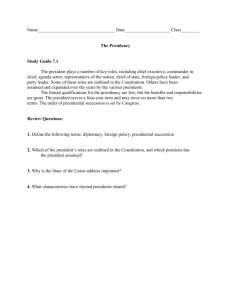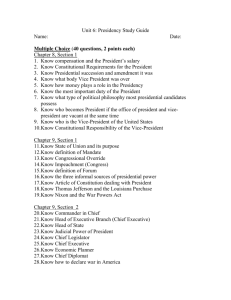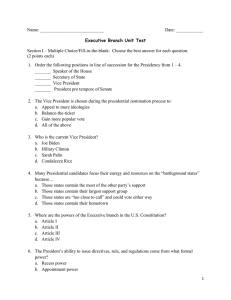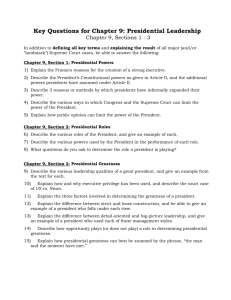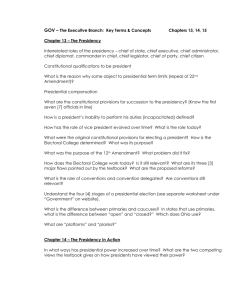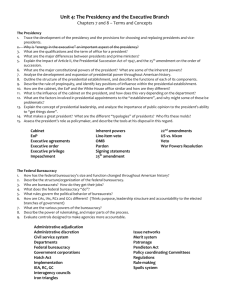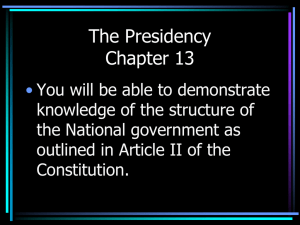13 The Presidency
advertisement
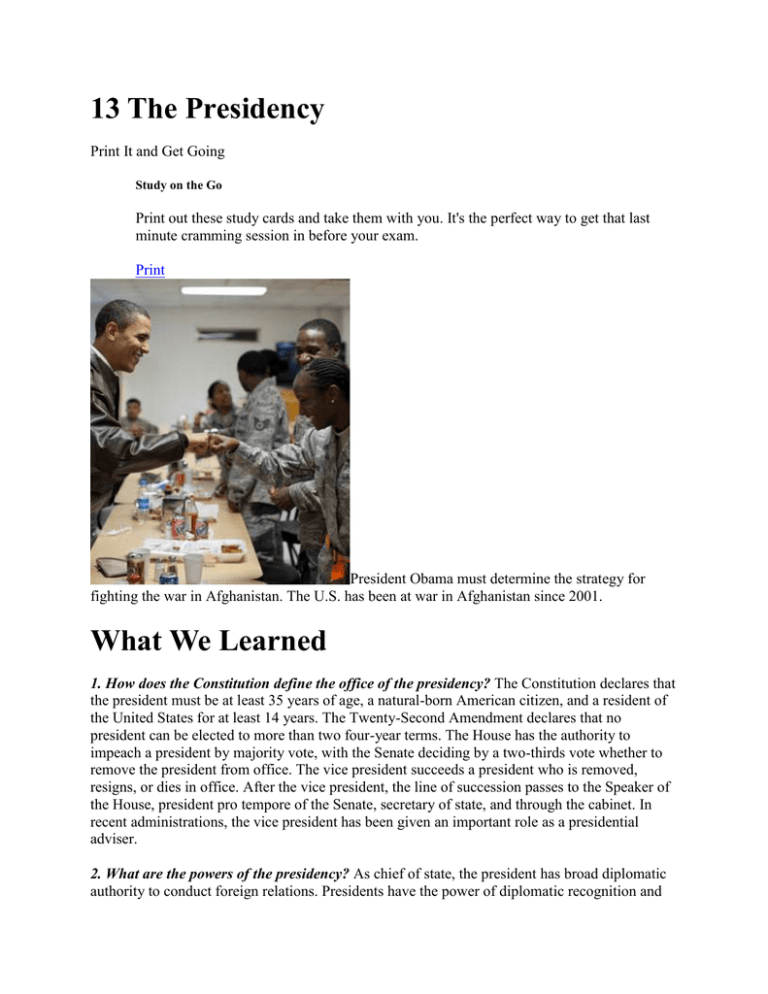
13 The Presidency Print It and Get Going Study on the Go Print out these study cards and take them with you. It's the perfect way to get that last minute cramming session in before your exam. Print President Obama must determine the strategy for fighting the war in Afghanistan. The U.S. has been at war in Afghanistan since 2001. What We Learned 1. How does the Constitution define the office of the presidency? The Constitution declares that the president must be at least 35 years of age, a natural-born American citizen, and a resident of the United States for at least 14 years. The Twenty-Second Amendment declares that no president can be elected to more than two four-year terms. The House has the authority to impeach a president by majority vote, with the Senate deciding by a two-thirds vote whether to remove the president from office. The vice president succeeds a president who is removed, resigns, or dies in office. After the vice president, the line of succession passes to the Speaker of the House, president pro tempore of the Senate, secretary of state, and through the cabinet. In recent administrations, the vice president has been given an important role as a presidential adviser. 2. What are the powers of the presidency? As chief of state, the president has broad diplomatic authority to conduct foreign relations. Presidents have the power of diplomatic recognition and they negotiate treaties and executive agreements with other nations. The president is commander in chief of the armed forces. The president is able to take some actions, particularly in the area of foreign and defense policy, because of inherent powers, which are those powers vested in the national government which do not depend on any specific grant of authority by the Constitution. The president nominates all federal judges pending majority-vote confirmation by the Senate and has the authority to grant pardons and reprieves. As chief executive, the president is empowered to issue executive orders, which presidents have used to enact important policies. The Constitution gives the president some tools for influencing the legislative process, including the veto. Recent presidents have used signing statements to identify provisions of bills that that they considered unconstitutional limitations on their authority as president that they intend to ignore or treat as advisory. 3. How did the modern presidency develop? Since the nineteenth century, the presidency has moved from the periphery of national politics to its center. Presidential power grows during time of crises, such as wars and economic depressions, because they increase public pressure for the government to act. Political scientists identify three factors responsible for the modern presidency: 1) the United States has emerged as a world power; 2) the presidential selection process favors individuals with big ideas rather than party loyalists, and 3) the executive branch of government has grown. 4. How does the presidential bureaucracy assist the chief executive in carrying out the duties of the office? The development of the modern presidency has been accompanied by a significant growth in the size and power of the presidential bureaucracy. The White House staff, which is chosen without need of Senate confirmation, gives the president advice on policy issues and politics, screens key appointments, manages press relations, organizes the president’s workday, and ensures that the president's wishes are carried out. The Executive Office of the President is the group of White House offices and agencies that develop and implement the policies and programs of the president. An efficient, professional staff can further the president's policy goals and create an image of presidential competence. An inefficient staff makes the president appear incompetent. 5. What different approaches do political scientists use to understand the concept of presidential power? Political scientists take different approaches to describing and explaining presidential leadership. Barber believes that a president's performance in office depends on personality traits, classified along two dimensions-- the amount of energy an individual brings to the office and the president's attitude toward the job. Greenstein identifies six qualities associated with effective presidential leadership: communication skills, organizational skills, political skills, vision, cognitive skill, and emotional intelligence. Neustadt believes that presidents succeed or fail based on their skills as political bargainers and coalition builders. Kernell contends that contemporary presidents often must adopt a media-oriented strategy, which he calls “going public,” if they are to achieve their goals in today's political environment. A number of political scientists point out that presidents have unilateral tools of power, including executive orders, executive agreements, presidential signing statements, and recess appointments. 6. What factors affect presidential popularity? Popular presidents are more influential than unpopular presidents. The tendency of a president to enjoy a high level of public support during the early stages of an administration is known as the honeymoon effect. Once a new president begins making policy decisions, opposition leaders and the media begin to criticize the performance and the president’s popularity falls. In domestic policy matters, presidential popularity rises with good news and falls with bad news, especially news concerning the economy. Presidential popularity rises dramatically during times of international crisis because of the rally effect. Tips for Success Study in groups: Identify other serious students in your class and suggest meeting at a coffee shop or an all-night restaurant for study sessions. Students who study together motivate one another. Key Terms Chief Executive the head of the executive branch of government Chief of State the official head of government Civilian Supremacy of The Armed Forces the concept that the armed forces should be under the direct control of civilian authorities Executive Agreement an international understanding between the president and foreign nations that does not require Senate ratification Executive office of The President the group of White House offices and agencies that develop and implement the policies and programs of the president Executive Order a directive issued by the president to an administrative agency or executive department Honeymoon Effect the tendency of a president to enjoy a high level of public support during the early months of an administration Impeachment a process in which an executive or judicial official is formally accused of an offense that could warrant removal from office Inherent Powers powers vested in the national government, particularly in the area of foreign and defense policy, which do not depend on any specific grant of authority by the Constitution, but rather exist because the United States is a sovereign nation Lame Duck an official whose influence is diminished because the official either cannot or will not seek reelection National Security Council (NSC) an agency in the Executive office of the President that advises the chief executive on matters involving national security Office of Management And Budget (OMB) an agency that assists the president in preparing the budget Pardon an executive action that frees an accused or convicted person from all penalties for an offense Presidential Signing Statement a pronouncement issued by the president at the time a bill passed by Congress is signed into law Rally Effect the tendency of the general public to express support for the incumbent president during a time of international threat Reprieve an executive action that delays punishment for a crime War Powers Act a law limiting the president’s ability to commit American armed forces to combat abroad without consultation with Congress and congressional approval Discussion Questions 1. What role does the vice president play in American politics? 2. What does it mean that the power of the president is the power to persuade? How does the modern president use the media to achieve goals? 3. Do you favor repealing the Twenty-Second Amendment (which limits the president to two four-year terms)? Why or why not? 4. How does the War Powers Act limit the president’s authority over military policy? Is the War Powers Act effective? 5. What factors affect a president’s popularity? How does presidential popularity influence presidential power? Interactive Activity Timeline: The Executive Order Over Time Every president in U.S. history has used the executive order to make changes in the policies of federal agencies. Although executive orders are intended to provide clarification on how to implement laws the Congress has passed, these orders have the force of law. Some orders have elicited great controversy as a president may use them to bypass Congress, and in so doing, overstep the authority of the executive branch. What do presidents usually use them for? Have presidents always had this power? Which executive orders have been controversial and was the president justified in signing them? In this activity, you will examine these and other issues as you explore some of the more significant executive orders throughout history and the effects they have had on American politics. In the process, you will evaluated the legality of executive orders and determine under which circumstance presidents have issued them. View Timeline “Talking About American Government” Podcasts Author Neal Tannahill discusses the most important concepts in this chapter Approval Ratings for President Obama, 2009 Judicial Selection Bush Approval Presidential Popularity
